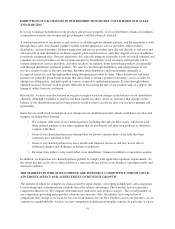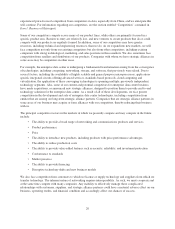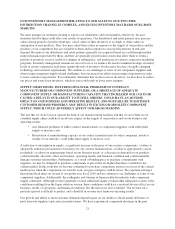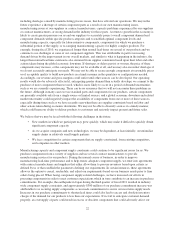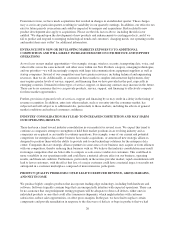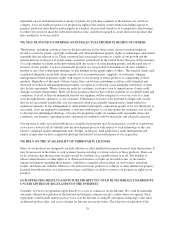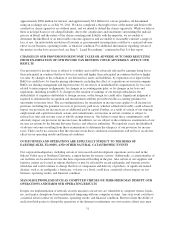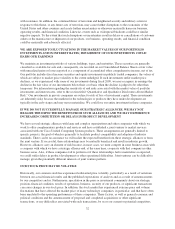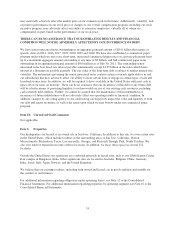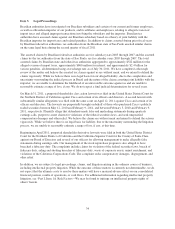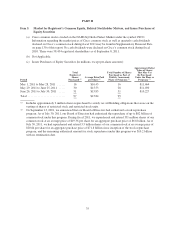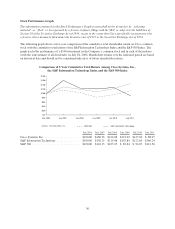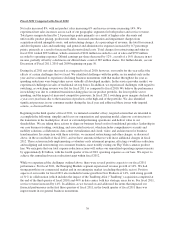Cisco 2011 Annual Report Download - page 37
Download and view the complete annual report
Please find page 37 of the 2011 Cisco annual report below. You can navigate through the pages in the report by either clicking on the pages listed below, or by using the keyword search tool below to find specific information within the annual report.dependent on any individual patents or group of patents for particular segments of the business for which we
compete, if we are unable to protect our proprietary rights to the totality of the features (including aspects of
products protected other than by patent rights) in a market, we may find ourselves at a competitive disadvantage
to others who need not incur the substantial expense, time, and effort required to create innovative products that
have enabled us to be successful.
WE MAY BE FOUND TO INFRINGE ON INTELLECTUAL PROPERTY RIGHTS OF OTHERS
Third parties, including customers, have in the past and may in the future assert claims or initiate litigation
related to exclusive patent, copyright, trademark, and other intellectual property rights to technologies and related
standards that are relevant to us. These assertions have increased over time as a result of our growth and the
general increase in the pace of patent claims assertions, particularly in the United States. Because of the existence
of a large number of patents in the networking field, the secrecy of some pending patents, and the rapid rate of
issuance of new patents, it is not economically practical or even possible to determine in advance whether a
product or any of its components infringes or will infringe on the patent rights of others. The asserted claims and/
or initiated litigation can include claims against us or our manufacturers, suppliers, or customers, alleging
infringement of their proprietary rights with respect to our existing or future products or components of those
products. Regardless of the merit of these claims, they can be time-consuming, result in costly litigation and
diversion of technical and management personnel, or require us to develop a non-infringing technology or enter
into license agreements. Where claims are made by customers, resistance even to unmeritorious claims could
damage customer relationships. There can be no assurance that licenses will be available on acceptable terms and
conditions, if at all, or that our indemnification by our suppliers will be adequate to cover our costs if a claim
were brought directly against us or our customers. Furthermore, because of the potential for high court awards
that are not necessarily predictable, it is not unusual to find even arguably unmeritorious claims settled for
significant amounts. If any infringement or other intellectual property claim made against us by any third party is
successful, if we are required to indemnify a customer with respect to a claim against the customer, or if we fail
to develop non-infringing technology or license the proprietary rights on commercially reasonable terms and
conditions, our business, operating results, and financial condition could be materially and adversely affected.
Our exposure to risks associated with the use of intellectual property may be increased as a result of acquisitions,
as we have a lower level of visibility into the development process with respect to such technology or the care
taken to safeguard against infringement risks. Further, in the past, third parties have made infringement and
similar claims after we have acquired technology that had not been asserted prior to our acquisition.
WE RELY ON THE AVAILABILITY OF THIRD-PARTY LICENSES
Many of our products are designed to include software or other intellectual property licensed from third parties. It
may be necessary in the future to seek or renew licenses relating to various aspects of these products. There can
be no assurance that the necessary licenses would be available on acceptable terms, if at all. The inability to
obtain certain licenses or other rights or to obtain such licenses or rights on favorable terms, or the need to
engage in litigation regarding these matters, could have a material adverse effect on our business, operating
results, and financial condition. Moreover, the inclusion in our products of software or other intellectual property
licensed from third parties on a nonexclusive basis could limit our ability to protect our proprietary rights in our
products.
OUR OPERATING RESULTS AND FUTURE PROSPECTS COULD BE MATERIALLY HARMED BY
UNCERTAINTIES OF REGULATION OF THE INTERNET
Currently, few laws or regulations apply directly to access or commerce on the Internet. We could be materially
adversely affected by regulation of the Internet and Internet commerce in any country where we operate. Such
regulations could include matters such as voice over the Internet or using IP, encryption technology, sales taxes
on Internet product sales, and access charges for Internet service providers. The adoption of regulation of the
29


